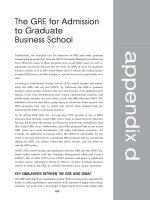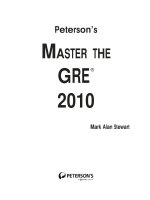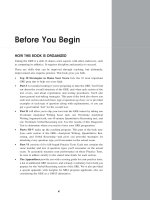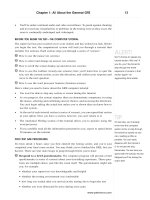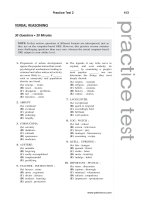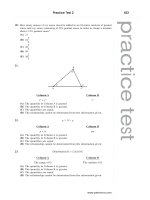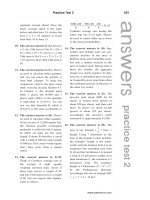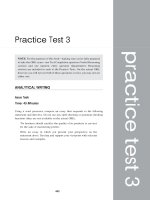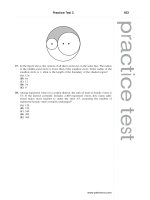Tài liệu Master the Gre 2010 - Part 7 ppt
Bạn đang xem bản rút gọn của tài liệu. Xem và tải ngay bản đầy đủ của tài liệu tại đây (52.91 KB, 10 trang )
KEY FACTS ABOUT GRE PROBLEM SOLVING QUESTIONS
• Numerical answer choices for a multiple-choice question will be listed in order,
from lowest to highest in value or vice versa.
• Data analysis questions, which involve charts, tables, or other data presented in
graphical form, often come in sets of two to four consecutive questions. In such
cases, all the questions in the set will pertain to the same graphical data.
• Geometry figures are not necessarily drawn to scale.
• Expect that nearly half of the questions will involve story problems in a real-
world setting.
• Expect one (but no more than one) numeric-entry question among the 14 Problem
Solving questions—but keep in mind that you might not see any at all.
• On the computer-based test, Problem Solving questions are mixed with Quanti-
tative Comparisons in no fixed pattern.
THE VERBAL REASONING SECTION
The 30-minute Verbal Reasoning section consists of 30 questions in four basic formats:
Sentence and Text Completion, Reading Comprehension, Analogies, and Antonyms.
Each format covers a distinct set of verbal and verbal reasoning skills.
Sentence and Text Completion
Sentence Completions are designed to measure the following four verbal skills (the first
one is the primary skill being tested):
Your ability to understand the relationships among ideas in a sentence and your
ability to choose how best to convey those ideas and relationships
Your grasp of vocabulary
Your facility with English-language idioms
Your diction (skill at using appropriate words in appropriate contexts)
For each test item, your task is to fill in either one or two blanks in a sentence in a
way that makes sense and effectively conveys the intended meaning of the sentence.
Most GRE Sentence Completions involve two blanks. Directions for these questions
are similar to the following:
Directions: The following question provides a sentence containing one or two
blanks, each blank indicating that something has been omitted. Beneath the
sentence are five lettered words or sets of words. Choose the word or set of words
for each blank that best fits the meaning of the sentence as a whole.
Here’s a Sentence Completion example that contains one blank. This question is
easier than average.
Chapter 2: GRE Questions—A First Look 43
.................................................................
..............................................................................................
www.petersons.com
Because frogs have no hair, skin, or feathers to protect their paper-thin
skin, they are _______ changes in the quality of the air and water in their
immediate environment.
(A) impervious to
(B) vulnerable to
(C) benumbed by
(D) responsive to
(E) invigorated by
The correct answer is (B). The sentence’s overall grammatical structure sug-
gests a cause-and-effect relationship between the unprotected nature of a frog’s
skin and whatever phrase should replace the blank. The fact that something is
“unprotected” makes it vulnerable—by the very definitions of the two words.
Now here’s a more challenging Sentence Completion. Notice that the sentence con-
tains two blanks and that each choice provides completions for both blanks. This is
how all two-blank Sentence Completions are designed.
Many avid hikers thrive on the _______ of peril and natural beauty, both of
which are part and parcel of a trek over treacherous yet _______ terrain.
(A) dual prospect . . navigable
(B) promise . . hazardous
(C) dichotomy..alluring
(D) juxtaposition . . unspoiled
(E) excitement . . beautiful
The correct answer is (D). To complete this sentence, it’s easier to start with
the second blank. The sentence’s grammatical structure sets up a parallel
between the phrase “peril and natural beauty” and the phrase “treacherous yet
_______,” so it would make sense to fill in the second blank with a word whose
meaning is similar to natural beauty. You can easily eliminate choices (A) and (B).
You can probably eliminate choice (E) as well. Comparing natural beauty to
beautiful is redundant; so although beautiful makes some sense in the blank, the
result is less than artful. That leaves choices (C) and (D), alluring and unspoiled.
Since we’ve already eliminated choices (A), (B), and (E), the only viable choices
for the first blank are dichotomy and juxtaposition, choices (C) and (D). Both
words make sense in context, but juxtaposition is better. Moreover, the phrase
juxtaposition of is idiomatic, while the phrase dichotomy of is not. (The proper
idiom is dichotomy between.)
KEY FACTS ABOUT GRE SENTENCE COMPLETIONS
• At least one Sentence Completion item will contain one blank, but most will
contain two blanks.
• Dual-blank completions come in pairs; you won’t complete one blank indepen-
dently of the other.
• For dual-blank Sentence Completions, the completion for one blank must make
sense together with the accompanying completion for the other blank.
PART I: GRE Basics44
.................................................................
..............................................................................................
www.petersons.com
• The best completion (the correct answer) will give the sentence an overall
meaning that makes perfect sense and that will be grammatically and idiomati-
cally proper.
• Difficult Sentence Completions are more likely to incorporate challenging
vocabulary either into the sentence itself or in the answer choices.
Text Completions
The Text Completion format is relatively new on the GRE. No more than one question in
this format will appear on your test. Text Completions measure the same set of verbal
skills as Sentence Completions do (see above), but they’re a bit more complex. Here are
the key features of this format:
• The text will be a one- to five-sentence passage containing two or three blanks
labeled with Roman numerals.
• You select the best of three choices for each blank.
• You receive credit only if you fill in all blanks correctly; no partial credit is
awarded.
The Text Completion format allows you to select any combination of choices. Your
challenge is to fill in the blanks in a way that makes the most sense; that most
effectively conveys the intended meaning of the passage as a whole; and that is correct
in diction, usage, and idiom.
Directions for GRE Text Completions are similar to the following:
Directions: Select one entry from each column to fill in the corresponding
blanks in the text. Fill in the blanks in a way that provides the best completion
for the text.
Here’s a moderately difficult example of a GRE Text Completion involving three fill-in
blanks. Notice that the choices for each blank are not lettered. On the test, you’ll
select your fill-in choices by clicking directly on them with your mouse.
The qualities expected of professional musicians, who must be disciplined
and technically precise while bringing passion and (i)__________ to each
performance, seem (ii)__________. This is especially true in jazz, where
extended improvisation based on a myriad of scales is part and parcel of
performance. The be-bop musicians of the 1950s and 1960s took this
duality to the highest level, by establishing a new set of harmonic rules
(iii)__________ that these rules existed only to be violated.
Blank (i)
virtuosity
spontaneity
impulsiveness
Blank (ii)
ambiguous
paradoxical
unattainable
Blank (iii)
and then insisting
but disagreeing
conforming to the view
The correct answer is as follows: (i) spontaneity; (ii) paradoxical;
(iii) and then insisting. Discipline and technical precision are generally
thought of as being contrary to passion, so the first sentence suggests that
a good professional musician must exhibit contradictory or opposing
Chapter 2: GRE Questions—A First Look 45
.................................................................
..............................................................................................
www.petersons.com
qualities. The word paradoxical captures the sense of contradiction, and
spontaneity fits nicely with passion and contrasts appropriately with
“disciplined.” The point of the final sentence is that be-bop musicians
epitomized the paradox, or “duality”—by establishing a set of rules and
then insisting on breaking them.
KEY FACTS ABOUT GRE TEXT COMPLETIONS
• Passage length ranges from one to five sentences.
• The format allows you to select a choice for one blank independently of your
choice for another blank.
• You select a fill-in choice by clicking directly on it with your mouse (choices are
not lettered).
• The best combination of choices will make for an excellent sentence or paragraph
that’s cohesive and rhetorically effective as well as correct in grammar, diction,
and idiom.
• Primary emphasis is on idiom, sense, and paragraph structure; secondary
emphasis is on vocabulary.
• You must choose the best completion for all blanks to earn credit for a correct
response.
Reading Comprehension
Reading Comprehension questions measure your ability to read carefully and accu-
rately, to determine the relationships among the various parts of the passage, and to
draw reasonable inferences from the material in the passage. The passages cover a
variety of subjects, including the humanities, the social sciences, the physical sciences,
ethics, philosophy, law, popular culture, and current events. Sources include profes-
sional journals, dissertations, and periodicals of intellectual interest. The test makers
edit the source material so it’s appropriate for GRE purposes.
The directions for Reading Comprehension are very straightforward, similar to the
following:
Directions: The following passage is accompanied by questions based on its
content. After reading the passage, choose the best answer to each question.
Answer all the questions on the basis of what is stated or implied in the passage.
Reading Comprehension passages can range from 150 words (about fifteen lines on
your computer screen) to 450 words (forty-five to fifty lines) long. Regardless of a
passage’s length, however, the emphasis is not on how quickly you can read but on
how well you understand what you read. Expect to encounter two to four sets of
questions (three sets is most common) and two to three questions per set. All ques-
tions in a set pertain to the same passage.
All Reading Comprehension questions are multiple choice (five choices), and most
questions focus on the following six specific tasks:
PART I: GRE Basics46
.................................................................
..............................................................................................
ALERT!
Your particular test might not
include a Text Completion
question, but be prepared for
one anyway.
www.petersons.com
recognizing the central idea or primary purpose of the passage
recalling information explicitly stated in the passage
making inferences from specific information stated in the passage
recognizing the purpose of specific passage information
applying and extrapolating from the ideas presented in the passage
understanding what specific words or phrases mean in the context of the passage
For practice, take a look at the following 200-word passage. Two questions based on it
will follow.
The post-WWI reinvigoration, or Renaissance, of Southern American
literature, which culminated during the 1940s with certain works of
William Faulkner and Tennessee Williams, shifted the focus of the region’s
literature away from the nobility of the Civil War’s lost cause to the war’s
enduring social and cultural consequences and the struggle for
individualism in the South’s culture of conformity. By the 1960s, however,
contemporary literature of the American South and its academic study had
become little more than a celebration of regional patriotism and local color.
The sort of literary imagination that had distinguished the Southern
Renaissance writers had waned, and no new writers were emerging to take
their place. Instead, a new genre, the nonfiction novel—in which fiction-
writing techniques are employed in the representation of real events—
seemed poised to supplant the nearly defunct novel. However, despite the
wide acclaim of Capote’s nonfiction novel In Cold Blood, and to the
surprise of all, this genre—and not the novel—soon withered away. The
next two decades saw a veritable explosion of talented young Southern
novelists whose imaginative works captured the attention of readers and
literary critics around the world.
Here’s a question based on the passage. This question is of average difficulty.
It can be inferred from the information in the passage that
(A) literature of the American South reached its peak in popularity during
the 1960s
(B) the writers of the Southern Renaissance wrote mainly novels
(C) no writer of any significance took the place of the Southern Renaissance
writers
(D) very few famous American authors have emerged from the South
(E) literary scholars tend to underestimate the potential influence of fiction
writers
The correct answer is (B). Choice (A) contradicts the fact that the new breed of
Southern writers were “read and reviewed worldwide,” which suggests that their
novels were at least as popular as those of the 1960s Renaissance. In contrast,
choice (B) is well-supported by the passage’s information. Though the passage’s
author does not explicitly state that the Southern Renaissance writers were novel
writers, the inference is reasonable based on the passage as a whole. Choice (C)
Chapter 2: GRE Questions—A First Look 47
.................................................................
..............................................................................................
www.petersons.com
